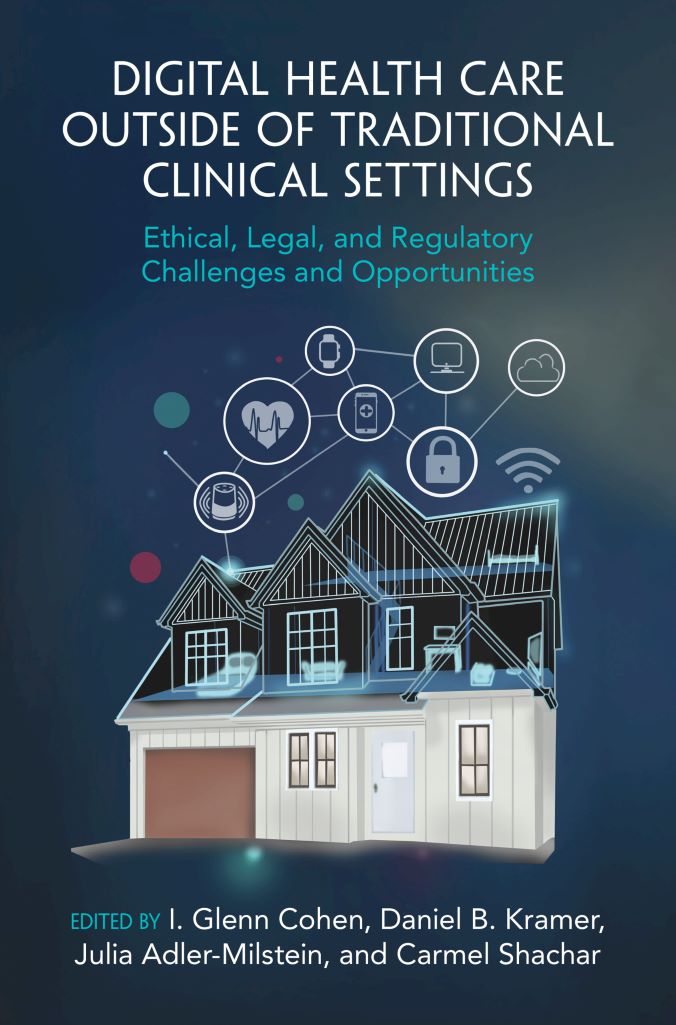New volume published: “Digital Health Care Outside of Traditional Clinical Settings: Ethical, Legal, and Regulatory Challenges and Opportunities”

This edited volume is based on the Petrie-Flom Center’s 2022 annual conference, Diagnosing in the Home: The Ethical, Legal, and Regulatory Challenges and Opportunities of Digital Diagnostics and Therapeutics outside of Traditional Clinical Settings, which brought experts together to consider the recent explosion of at-home digital health care and explore the ethical, legal, regulatory, and reimbursement challenges and opportunities of this shift away from the 20th-century focus on clinics and hospitals towards a more modern model.
This conference was organized in collaboration with I. Glenn Cohen, Julia Adler-Milstein, University of California San Francisco, and Daniel Kramer, Harvard Medical School, and Carmel Shachar, Harvard Law School.
This book is open access.
From the Publisher
Health care delivery is shifting away from the clinic and into the home. Even prior to the COVID-19 pandemic, the use of telehealth, wearable sensors, ambient surveillance, and other products was on the rise. In the coming years, patients will increasingly interact with digital products at every stage of their care, such as using wearable sensors to monitor changes in temperature or blood pressure, conducting self-directed testing before virtually meeting with a physician for a diagnosis, and using smart pills to document their adherence to prescribed treatments. This volume reflects on the explosion of at-home digital health care and explores the ethical, legal, regulatory, and reimbursement impacts of this shift away from the 20th-century focus on clinics and hospitals towards a more modern health care model.
About the 2022 Petrie-Flom Center Annual Conference
Even prior to the COVID-19 pandemic, healthcare delivery was already shifting away from the clinic and into the home, utilizing telehealth, wearable sensors, ambient surveillance, and other products. The COVID-19 pandemic has shown the value of when “health care comes home.” Trends such as facilitating aging at home for seniors, keeping patients out of the clinic as much as possible, and telehealth have only been accelerated by the pandemic. For example, telehealth made up 50% of all physician visits in mid-April 2020 in response to the pandemic, and continues to grow far past pre-pandemic rates.
We are currently in a unique position to reflect on the 2020-21 explosion of at-home digital health care and to think through the ethical and legal challenges and opportunities of this shift, finally leaving the 20th century focus on the clinic and the hospital for a more modern model. Patients will increasingly interact with digital products from the start of their care, using wearable sensors to monitor changes in temperature or blood pressure, conducting home or self-directed testing before virtually meeting with a physician for a diagnosis, and then using smart pills to document their adherence to the prescribed treatment. Some of these products may be direct to consumer while others will be designed to be integrated into the existing health care system. Some medical care may be relatively easier to translate from the clinic to the home due to factors, such as pre-existing clinician/patient relationships. Other services, such as diagnostics, may prove more complicated to shift into the home.
This year’s conference is organized in collaboration with Julia Adler-Milstein, Professor of Medicine and Director of the Center for Clinical Informatics and Improvement Research at University of California San Francisco, and Daniel Kramer, Assistant Professor of Medicine at Beth Israel Deaconess Medical Center.